BLOG
*** This page might not be translated. ***
![]()
2019-04-10 20:58
村の住人としての意識って何だろう?やめていいイベントではないのかな?ふっとよぎる疑問。村の昔からの宗教
イベントに参加する住人がほとんどいない。高齢化、過疎化、仕事の都合、様々な理由があるが、毎年その役に付いた人以外に参加者、参拝者がいないというのはどういうことだろう?
毎年、お釈迦様の誕生日は各地で’花祭り’と呼ばれ甘茶をふるまうイベントが行われる。我が塩成の村の庵寺でも檀家総代が仕切り、花祭りを行っている。余談だが、前回も紹介した塩成の庵寺の不思議,臨海山寶手庵に、‵紀元二千六百十六年再建’という掛札を見つけた。お釈迦様の誕生は定かではないが、およそ2400年前頃との説がある。それと関連しているのかどうか、不思議に思っている。
私が子供の頃は、甘茶がうれしくて、ほとんどの村人が来ていたような記憶がある。近年、私がUターンで帰郷してからは、檀徒総会の役員3名のほか、3,4人が参加すればいいほうだという。昨日の、一之宮神社の春祭りはまさに神社総代の役員3名のほか、参拝者はいなかったようだ。
その疑問はひとまずおいて、2019年今年の我が村の花祭りを紹介したい。
2日前に、檀徒総代のひとりが庵寺の掃除、草刈りをして、甘茶の準備をした。当日、朝7時には庵寺を開け、お釈迦様の甘茶用の器とお釈迦様をだして、そのあづまやの屋根や器の周りに花をかざった。甘茶は役員の家でわかして準備して持ってこられた。午前8時、誰も来ない、9時、近所の住人で毎年必ず来て下さるご夫婦が来られた。9時半一人、、しばらくして、一人、さらに近所のおばさんが一人、そして今日仕事が休みだというおひとりが来てくださった。片づけ始めた最後に隣村からお一人が飛び入り参加、役員、私含めて合計10名!今年はよく集まった!! という現実。
この日を待ってたように庵寺に植えられたソメイヨシノ桜が満開。うららかな、暖かい一日、庵寺の縁側で花見を楽しめた。




桜の花は、咲き始めは花弁の内側が白く、散るころにはうっすらとピンクになるという。よく見るとなるほどと、新しい発見に嬉しくなった。散る間際は美しく装うのだと。庵寺の敷地にソメイヨシノ桜が3本植えられているが老木となり、危険が生じて、今年の花を最後に切られるらしいという。


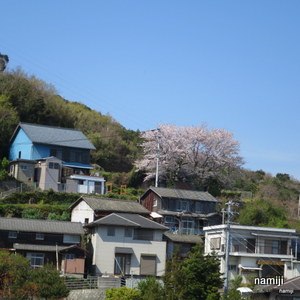
私が子供の頃、庵寺に近所のおばあちゃんたちが何気なく集まって、おしゃべりをしていた光景を覚えている。今日、村の多くの高齢のおじいさん、おばあさんは、一日話す相手もなく、孤独をかこっている。かつてのように,良きも悪しきもうわさ話などをしながら、何気なく集まってくるような光景は見られない。
過疎化の止まらない村の生活だが、何の支障もない。当たり前の日々が当たり前のように今日、明日と続く。何が幸せなのか、より楽しい生活があるのか、など考えることもない。
ひとまず置いた疑問だが、桜の散り際の潔さ、粋を感じながら、’ここで生きる’こと!、まとわり続くだろう疑問にまた引き戻される。
イベントに参加する住人がほとんどいない。高齢化、過疎化、仕事の都合、様々な理由があるが、毎年その役に付いた人以外に参加者、参拝者がいないというのはどういうことだろう?
毎年、お釈迦様の誕生日は各地で’花祭り’と呼ばれ甘茶をふるまうイベントが行われる。我が塩成の村の庵寺でも檀家総代が仕切り、花祭りを行っている。余談だが、前回も紹介した塩成の庵寺の不思議,臨海山寶手庵に、‵紀元二千六百十六年再建’という掛札を見つけた。お釈迦様の誕生は定かではないが、およそ2400年前頃との説がある。それと関連しているのかどうか、不思議に思っている。
私が子供の頃は、甘茶がうれしくて、ほとんどの村人が来ていたような記憶がある。近年、私がUターンで帰郷してからは、檀徒総会の役員3名のほか、3,4人が参加すればいいほうだという。昨日の、一之宮神社の春祭りはまさに神社総代の役員3名のほか、参拝者はいなかったようだ。
その疑問はひとまずおいて、2019年今年の我が村の花祭りを紹介したい。
2日前に、檀徒総代のひとりが庵寺の掃除、草刈りをして、甘茶の準備をした。当日、朝7時には庵寺を開け、お釈迦様の甘茶用の器とお釈迦様をだして、そのあづまやの屋根や器の周りに花をかざった。甘茶は役員の家でわかして準備して持ってこられた。午前8時、誰も来ない、9時、近所の住人で毎年必ず来て下さるご夫婦が来られた。9時半一人、、しばらくして、一人、さらに近所のおばさんが一人、そして今日仕事が休みだというおひとりが来てくださった。片づけ始めた最後に隣村からお一人が飛び入り参加、役員、私含めて合計10名!今年はよく集まった!! という現実。
この日を待ってたように庵寺に植えられたソメイヨシノ桜が満開。うららかな、暖かい一日、庵寺の縁側で花見を楽しめた。




桜の花は、咲き始めは花弁の内側が白く、散るころにはうっすらとピンクになるという。よく見るとなるほどと、新しい発見に嬉しくなった。散る間際は美しく装うのだと。庵寺の敷地にソメイヨシノ桜が3本植えられているが老木となり、危険が生じて、今年の花を最後に切られるらしいという。



私が子供の頃、庵寺に近所のおばあちゃんたちが何気なく集まって、おしゃべりをしていた光景を覚えている。今日、村の多くの高齢のおじいさん、おばあさんは、一日話す相手もなく、孤独をかこっている。かつてのように,良きも悪しきもうわさ話などをしながら、何気なく集まってくるような光景は見られない。
過疎化の止まらない村の生活だが、何の支障もない。当たり前の日々が当たり前のように今日、明日と続く。何が幸せなのか、より楽しい生活があるのか、など考えることもない。
ひとまず置いた疑問だが、桜の散り際の潔さ、粋を感じながら、’ここで生きる’こと!、まとわり続くだろう疑問にまた引き戻される。
![]()
2019-02-21 17:03
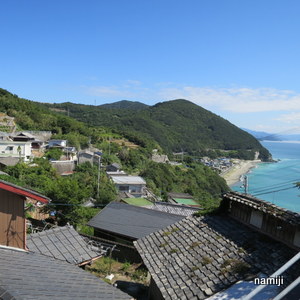

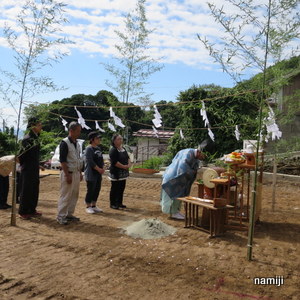



The Shinto ceremony of purifying a building site
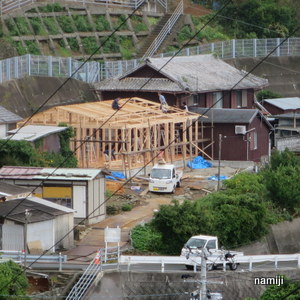





The ceremony of completion of framework, days afer, the completion of the house




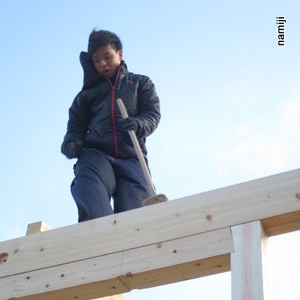
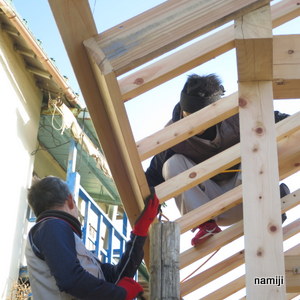




need some staff cooperation for setting up the framework, the wife of the master carpenter prepare dinner for the staffs on the day
![]()
2019-01-19 08:56
A Singaporean, Jessie is one of my friends, came at my house on the Christmas day in 2018.
She has been visited here almost every year or once two years. Her stay in Japan was usually for about two or three weeks and most of her holiday, she spent in my village. This time she came here in winter season, this makes her a lot of her health problems. It takes a little time for her to get used to cold weather.
However, she had good experiences this time. I would like to introduce her experiences along following photos*
From the port of the Sadamisaki peninsula, Kyushu is only 70 minutes trip by ferry. So, one day, we visited Kyushu, the famaous Onsen called Jigokumeguri, Kuju bridge which is the most longest hanging bridge in Japan, then drove to near the Aso mountain to take a look wide landscape from the drive way.
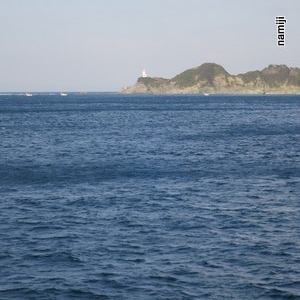



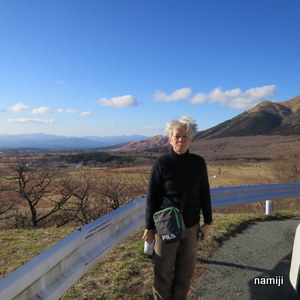


The other day,one of villagers, my friend tought us how to make Sasimi.His work was almost artist!



Even most of Japanese and our villagers have not experienced a traditional way of making MOCHI (rice cake) at a house.
The family was excellent, they did traditional way of using KINE and USU.(see photos)
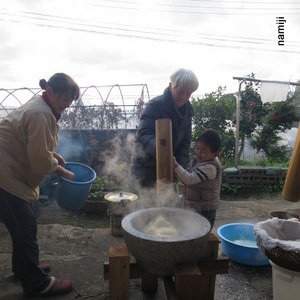



Next her experience was harvest of tangerines. The farmer taught her how to cut the stem and we ate the fresh tangerine at the field.
Then, she had experience of fishing. On the day, for lunch, the farmer's wife gave her cooking lesson, typical, however special cooking, CHIRASHIZUSI. This dish is usually made on family special day, regional festival etc.

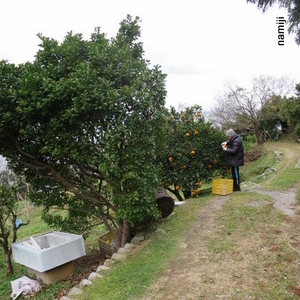








She wanted to work at field and kitchen like as my routine work. However, her health condition became worse, so, I suggested her to take the Asian treatment as you see the photo.





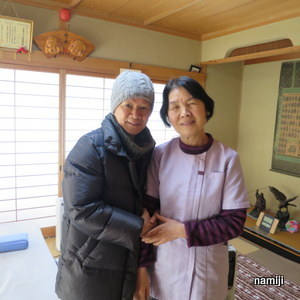
On the first day of 2019, we drove to the mountain terrace located almost center of the peninsula in order to watch the first sunrise of the new year. It was beautiful sunrise.
As Japanese traditional custom, we visited a shrine and temples for wishing our good health and happiness in new year. During her stay, sometimes she enjoyed working around village and taking Onsen etc.








The last day of staying at my village, she bought dried small fish for souvenir to her family in Singapore.
On the day for dinner, my friend invited us to her house and arranged old style cooking using SHICHIRIN, a kind of old style grill utensil. Nowadays, this is also very unusial experience for us even Japanese.




She has been visited here almost every year or once two years. Her stay in Japan was usually for about two or three weeks and most of her holiday, she spent in my village. This time she came here in winter season, this makes her a lot of her health problems. It takes a little time for her to get used to cold weather.
However, she had good experiences this time. I would like to introduce her experiences along following photos*
From the port of the Sadamisaki peninsula, Kyushu is only 70 minutes trip by ferry. So, one day, we visited Kyushu, the famaous Onsen called Jigokumeguri, Kuju bridge which is the most longest hanging bridge in Japan, then drove to near the Aso mountain to take a look wide landscape from the drive way.







The other day,one of villagers, my friend tought us how to make Sasimi.His work was almost artist!



Even most of Japanese and our villagers have not experienced a traditional way of making MOCHI (rice cake) at a house.
The family was excellent, they did traditional way of using KINE and USU.(see photos)




Next her experience was harvest of tangerines. The farmer taught her how to cut the stem and we ate the fresh tangerine at the field.
Then, she had experience of fishing. On the day, for lunch, the farmer's wife gave her cooking lesson, typical, however special cooking, CHIRASHIZUSI. This dish is usually made on family special day, regional festival etc.










She wanted to work at field and kitchen like as my routine work. However, her health condition became worse, so, I suggested her to take the Asian treatment as you see the photo.






On the first day of 2019, we drove to the mountain terrace located almost center of the peninsula in order to watch the first sunrise of the new year. It was beautiful sunrise.
As Japanese traditional custom, we visited a shrine and temples for wishing our good health and happiness in new year. During her stay, sometimes she enjoyed working around village and taking Onsen etc.








The last day of staying at my village, she bought dried small fish for souvenir to her family in Singapore.
On the day for dinner, my friend invited us to her house and arranged old style cooking using SHICHIRIN, a kind of old style grill utensil. Nowadays, this is also very unusial experience for us even Japanese.




![]()
2018-10-04 18:33
Late in June, I had a chance to visit Ho Chi Minh city (Saigon), Vietnam, with my sisters and a friend.
We arrived at Tan Son Nhat International airport and just stepped out from the arrival lobby. Suddenly, I was surrounded by that hot, humid air that is very characteristic of Southeast Asia. I like this feeling.
On the way to the hotel and also while taking an evening walk after hotel check-in, we saw unimaginable traffic conditions in the town. I and my party couldn’t cross the road in front of the hotel because the huge number of motorbikes and cars did not stop for us even though the traffic light for us was green. The hotel doorman said that in Vietnam, traffic priority was in this order - motorbikes, cars and then pedestrians!


For dinner, we went to a local restaurant. The meal was a very typical noodle made of rice flour.
Our first day was over, we were very tired - caused by the stress of traffic in the town.


On the second day, we joined a Mitoh Mekong Delta cruise (Thanh pho My “Tho”).
Mitoh is a new city well known for producing fruits.
The Mekong river is almost 4000km in length starting from the Himalayan Mountains and flowing down to the Indian Ocean.
We enjoyed the fruits and the boat cruise through the jungle.
Our stress on second day was caused by the Vietnamese currency, the Dong. We are not accustomed to prices with such a big number.



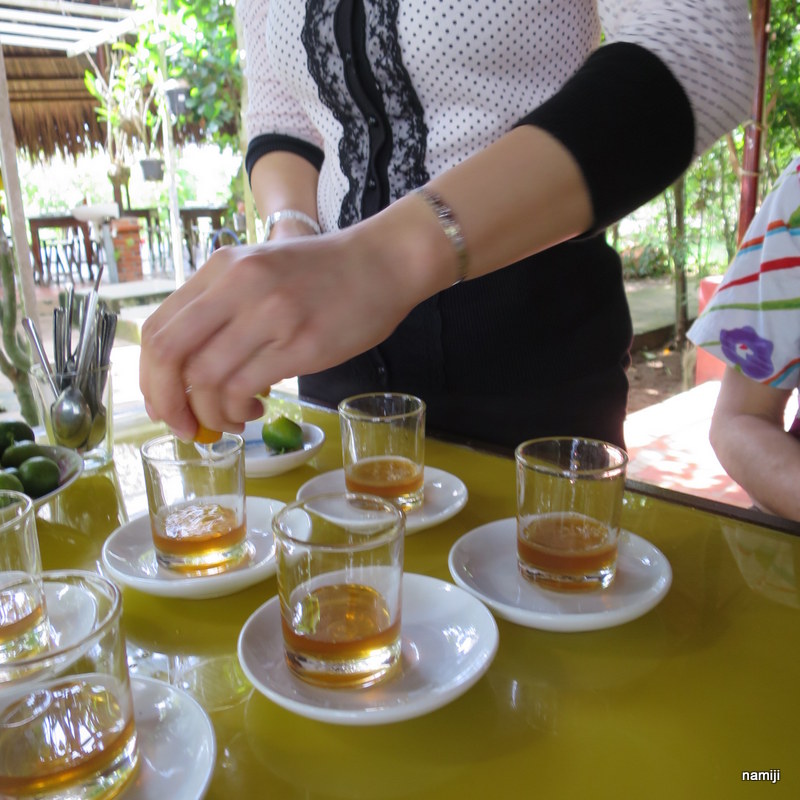





Mekong river, Kone island in the river, tasting of honey and fruits produced in the island and boat cruise through the jungle
On the third day, we enjoyed shopping and sightseeing. The town is a mix of modern urban buildings and old Vietnamese buildings full of history and nostalgia.






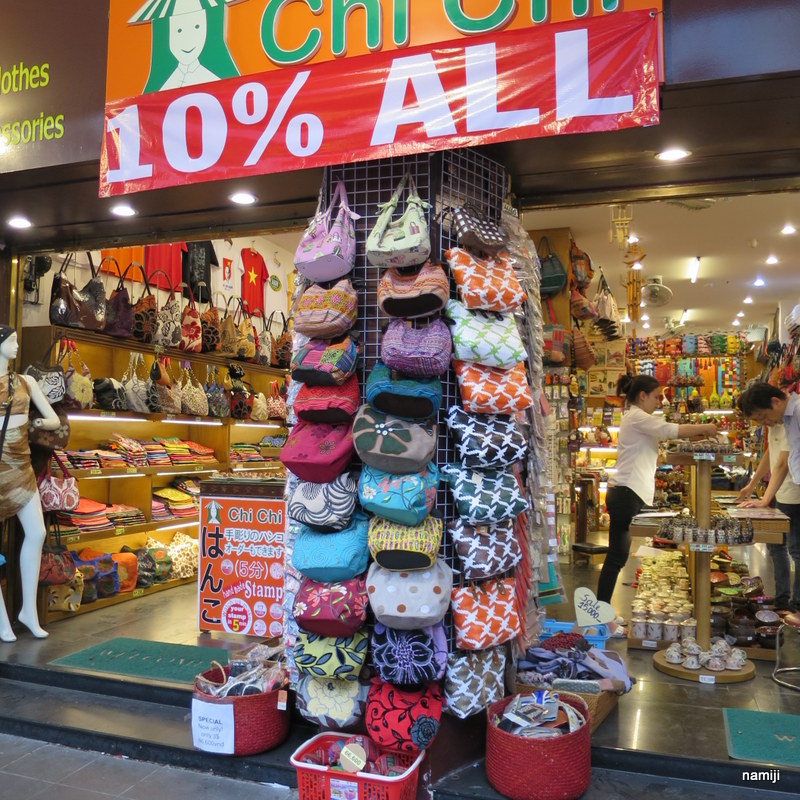

On the fourth day, after breakfast, we went for a walk around the hotel and by chance, found the local market. It was a very interesting place for us. We thought this market was typical of much of the Vietnamese life style.
In the morning, we had the experience of a Vietnamese-style massage. It costs 540,000 Dong, We felt the cost was very expensive compared to most other Vietnamese consumer prices.



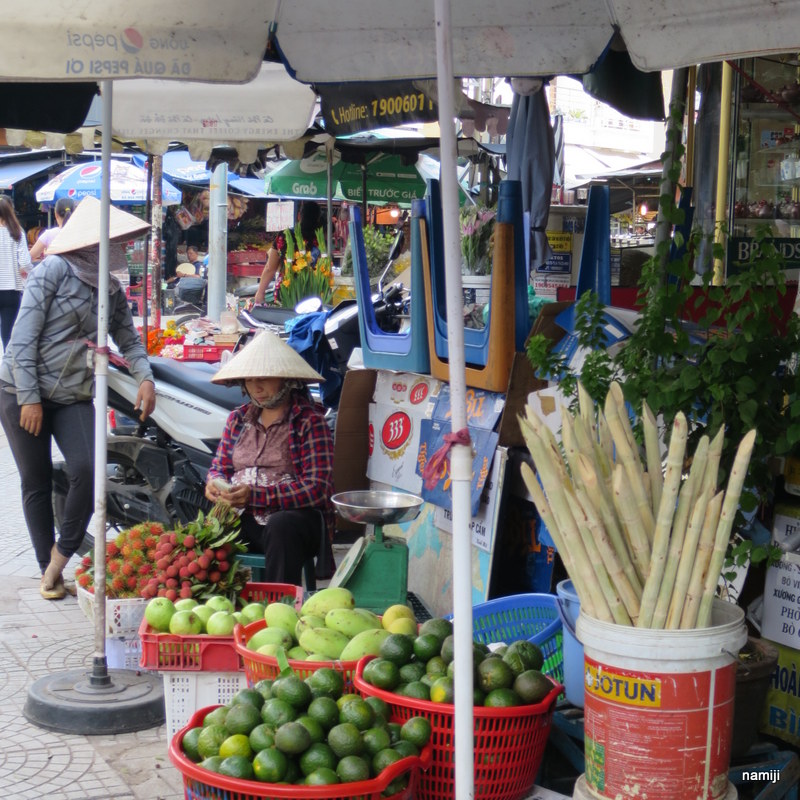


We arrived at Tan Son Nhat International airport and just stepped out from the arrival lobby. Suddenly, I was surrounded by that hot, humid air that is very characteristic of Southeast Asia. I like this feeling.
On the way to the hotel and also while taking an evening walk after hotel check-in, we saw unimaginable traffic conditions in the town. I and my party couldn’t cross the road in front of the hotel because the huge number of motorbikes and cars did not stop for us even though the traffic light for us was green. The hotel doorman said that in Vietnam, traffic priority was in this order - motorbikes, cars and then pedestrians!


For dinner, we went to a local restaurant. The meal was a very typical noodle made of rice flour.
Our first day was over, we were very tired - caused by the stress of traffic in the town.


On the second day, we joined a Mitoh Mekong Delta cruise (Thanh pho My “Tho”).
Mitoh is a new city well known for producing fruits.
The Mekong river is almost 4000km in length starting from the Himalayan Mountains and flowing down to the Indian Ocean.
We enjoyed the fruits and the boat cruise through the jungle.
Our stress on second day was caused by the Vietnamese currency, the Dong. We are not accustomed to prices with such a big number.








Mekong river, Kone island in the river, tasting of honey and fruits produced in the island and boat cruise through the jungle
On the third day, we enjoyed shopping and sightseeing. The town is a mix of modern urban buildings and old Vietnamese buildings full of history and nostalgia.








On the fourth day, after breakfast, we went for a walk around the hotel and by chance, found the local market. It was a very interesting place for us. We thought this market was typical of much of the Vietnamese life style.
In the morning, we had the experience of a Vietnamese-style massage. It costs 540,000 Dong, We felt the cost was very expensive compared to most other Vietnamese consumer prices.






Local market
For lunch, we had good Vietnamese meal at a restaurant named “Vietnam house”. The restaurant gave good service and had a Vietnamese style interior and atmosphere.




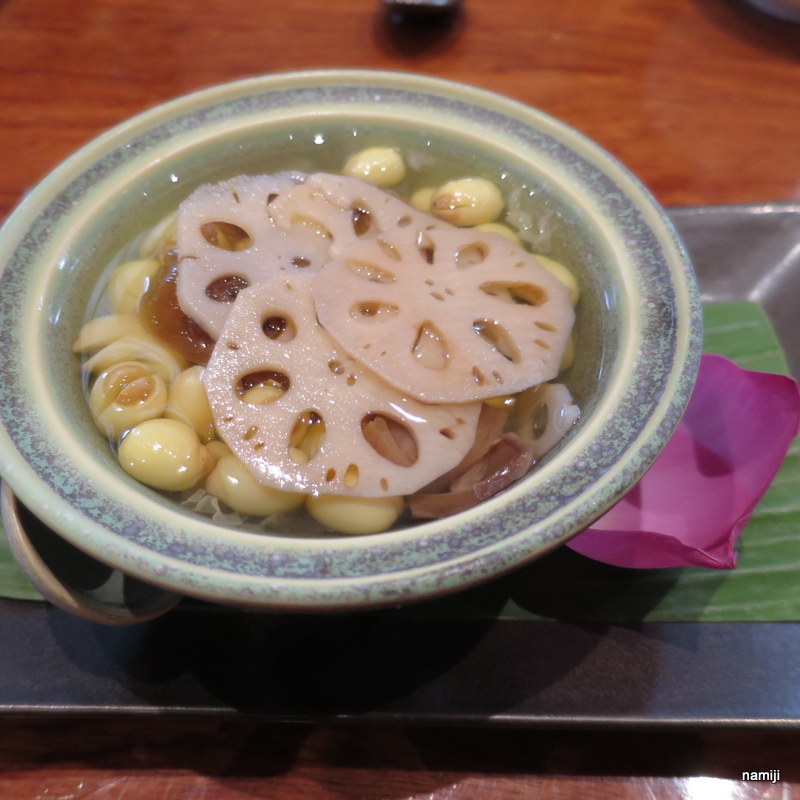







Before going to the airport, we had a little more time, so we went to a Puppet theater.
The show was a traditional play and music.



The show was a traditional play and music.



The Puppet theater show
Vietnamese people had hard time, enduring French rule, then civil war then the Vietnam War. Given this devastating history, they have achieved remarkable development.
Through our trip, I felt their strong energy and national pride and got the feeling of a bright future for the Vietnamese people.
Through our trip, I felt their strong energy and national pride and got the feeling of a bright future for the Vietnamese people.
![]()
2018-05-08 16:53
今年の冬はとても厳しい寒さにみまわれた。それだけに春の兆しは心もつぼみのように膨らんでいった。そんな春の日に、ささやかな、そしてリッチな気分を楽しむサロンを開いた。
まずは、三寒四温に戸惑う3月半ば、カフェ・ふ~ちゃんで、フルートとキーボードの音色を楽しみながらティーサロン。
8畳と3畳の小さな部屋で、触れ合える距離でたっぷりと楽しめる豊かなメロディー。よく晴れた一日、海の青も木々の芽吹きの緑もともに体を揺らしてその音色を楽しむ。




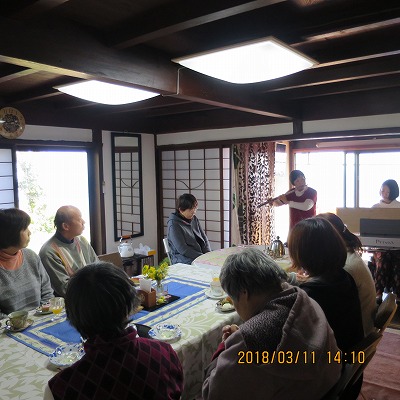
春爛漫,’春のお茶会~花とウクレレをたのしみながら~’とタイトルをつけたサロンはやはりカフェ・ふ~ちゃんで。
隣の庵寺の桜が見事に咲き、めいっぱいの春を花とウクレレと花ちゃんの歌声が演じた一日。半島の人々になかなか馴染みのないウクレレの軽快な音楽と花ちゃんの力強い、そして感情を込めた歌声が小さな部屋の壁を破り、人々の心の殻をやぶり、春霞のように柔らかく、自然に溶け込んでいく。






4月、さくらは終わり、緑が流れ出す。まさに自然の舞台、コンサートホールに、瀬戸内海に面する大江の山々が音響効果を、入り組んだ深い緑色をたたえた海が舞台の背景を作り上げた。大江の里の意味をつけた、’江里花だん’で行われたフルートとキーボードの音楽会。この日のために佐田岬半島の自然が全身で協力してくれたような、素晴らしい快晴、柔らかな春風、背にぬくもりを感じる春の日差し。江里花だんのご主人が速攻でこしらえた簡易舞台。奥様の丹念な手入れの行き届いた自然味豊かなガーデン。昼下がりのひと時、何にも増して自然芸術が繰り広げられた。




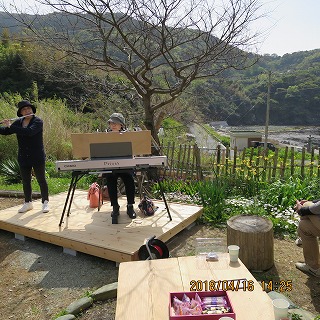

佐田岬の自然は何も真っ青な空、海が象徴するものではない。風の通り道、そして、太平洋と瀬戸内海に挟まれたスリムな岬はその海の影響を受けて、霧が発生しやすい。佐田岬のほぼ中央、山の上にリゾートハウスが並ぶ一角があり、風と霧の名所のようでもある。ここに’自然の庭’と名付け、プライベートの庭を一般公開している一軒の家がある。
4月の深く霧が立ち込めた一日、ここでもフルートとキーボードの美しい音色が山々を覆う深い霧の中に溶け込んでいった。晴れた日の木々や自然の花々に囲まれた時も素晴らしいが、こんなに雨の日、深い霧が似合う場所は多くないと感じた。

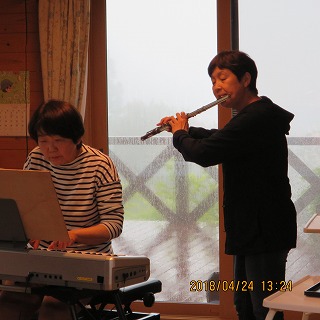


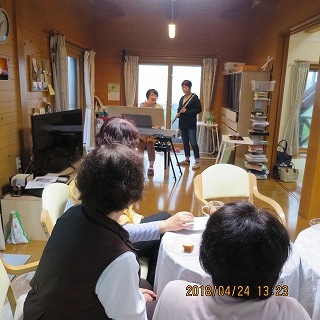
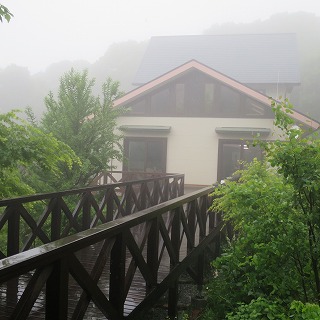

かつて、19世紀頃のヨーロッパ、あるいは日本の大正ロマンのように、手の届く位置で、音楽と会話、親しい人々との交流を深めるサロン文化は、富豪の屋敷の一室ではなくても、自然の中のささやかな場所で、そして、マスコミにしられた著名人でないが、こんなにも豊かな演奏家が身近にていて素晴らしい感動を与えてくれることを、私のように小さな村や町に住む人たちに知ってほしい。多くの人に楽しんで欲しいと願う。
まずは、三寒四温に戸惑う3月半ば、カフェ・ふ~ちゃんで、フルートとキーボードの音色を楽しみながらティーサロン。
8畳と3畳の小さな部屋で、触れ合える距離でたっぷりと楽しめる豊かなメロディー。よく晴れた一日、海の青も木々の芽吹きの緑もともに体を揺らしてその音色を楽しむ。





春爛漫,’春のお茶会~花とウクレレをたのしみながら~’とタイトルをつけたサロンはやはりカフェ・ふ~ちゃんで。
隣の庵寺の桜が見事に咲き、めいっぱいの春を花とウクレレと花ちゃんの歌声が演じた一日。半島の人々になかなか馴染みのないウクレレの軽快な音楽と花ちゃんの力強い、そして感情を込めた歌声が小さな部屋の壁を破り、人々の心の殻をやぶり、春霞のように柔らかく、自然に溶け込んでいく。






4月、さくらは終わり、緑が流れ出す。まさに自然の舞台、コンサートホールに、瀬戸内海に面する大江の山々が音響効果を、入り組んだ深い緑色をたたえた海が舞台の背景を作り上げた。大江の里の意味をつけた、’江里花だん’で行われたフルートとキーボードの音楽会。この日のために佐田岬半島の自然が全身で協力してくれたような、素晴らしい快晴、柔らかな春風、背にぬくもりを感じる春の日差し。江里花だんのご主人が速攻でこしらえた簡易舞台。奥様の丹念な手入れの行き届いた自然味豊かなガーデン。昼下がりのひと時、何にも増して自然芸術が繰り広げられた。






佐田岬の自然は何も真っ青な空、海が象徴するものではない。風の通り道、そして、太平洋と瀬戸内海に挟まれたスリムな岬はその海の影響を受けて、霧が発生しやすい。佐田岬のほぼ中央、山の上にリゾートハウスが並ぶ一角があり、風と霧の名所のようでもある。ここに’自然の庭’と名付け、プライベートの庭を一般公開している一軒の家がある。
4月の深く霧が立ち込めた一日、ここでもフルートとキーボードの美しい音色が山々を覆う深い霧の中に溶け込んでいった。晴れた日の木々や自然の花々に囲まれた時も素晴らしいが、こんなに雨の日、深い霧が似合う場所は多くないと感じた。







かつて、19世紀頃のヨーロッパ、あるいは日本の大正ロマンのように、手の届く位置で、音楽と会話、親しい人々との交流を深めるサロン文化は、富豪の屋敷の一室ではなくても、自然の中のささやかな場所で、そして、マスコミにしられた著名人でないが、こんなにも豊かな演奏家が身近にていて素晴らしい感動を与えてくれることを、私のように小さな村や町に住む人たちに知ってほしい。多くの人に楽しんで欲しいと願う。




